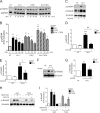Proteinase-activated receptor-2 transactivation of epidermal growth factor receptor and transforming growth factor-β receptor signaling pathways contributes to renal fibrosis
- PMID: 24253040
- PMCID: PMC3873584
- DOI: 10.1074/jbc.M113.492793
Proteinase-activated receptor-2 transactivation of epidermal growth factor receptor and transforming growth factor-β receptor signaling pathways contributes to renal fibrosis
Abstract
Chronic kidney diseases cause significant morbidity and mortality in the population. During renal injury, kidney-localized proteinases can signal by cleaving and activating proteinase-activated receptor-2 (PAR2), a G-protein-coupled receptor involved in inflammation and fibrosis that is highly expressed in renal tubular cells. Following unilateral ureteric obstruction, PAR2-deficient mice displayed reduced renal tubular injury, fibrosis, collagen synthesis, connective tissue growth factor (CTGF), and α-smooth muscle actin gene expression at 7 days, compared with wild-type controls. In human proximal tubular epithelial cells in vitro, PAR2 stimulation with PAR2-activating peptide (PAR2-AP) alone significantly up-regulated the expression of CTGF, a potent profibrotic cytokine. The induction of CTGF by PAR2-AP was synergistically increased when combined with transforming growth factor-β (TGF-β). Consistent with these findings, treating human proximal tubular epithelial cells with PAR2-AP induced Smad2/3 phosphorylation in the canonical TGF-β signaling pathway. The Smad2 phosphorylation and CTGF induction required signaling via both the TGFβ-receptor and EGF receptor suggesting that PAR2 utilizes transactivation mechanisms to initiate fibrogenic signaling. Taken together, our data support the hypothesis that PAR2 synergizes with the TGFβ signaling pathway to contribute to renal injury and fibrosis.
Keywords: Epidermal Growth Factor Receptor (EGFR); Fibrosis; Kidney; PAR2; Receptors; Transforming Growth Factor β (TGFβ).
Figures












Similar articles
-
Induction of renal fibrotic genes by TGF-β1 requires EGFR activation, p53 and reactive oxygen species.Cell Signal. 2013 Nov;25(11):2198-209. doi: 10.1016/j.cellsig.2013.07.007. Epub 2013 Jul 18. Cell Signal. 2013. PMID: 23872073
-
Angiotensin II induces connective tissue growth factor and collagen I expression via transforming growth factor-beta-dependent and -independent Smad pathways: the role of Smad3.Hypertension. 2009 Oct;54(4):877-84. doi: 10.1161/HYPERTENSIONAHA.109.136531. Epub 2009 Aug 10. Hypertension. 2009. PMID: 19667256
-
Protease-activated receptor 2 does not contribute to renal inflammation or fibrosis in the obstructed kidney.Nephrology (Carlton). 2019 Sep;24(9):983-991. doi: 10.1111/nep.13635. Epub 2019 Jul 31. Nephrology (Carlton). 2019. PMID: 31314137
-
Signaling Crosstalk of TGF-β/ALK5 and PAR2/PAR1: A Complex Regulatory Network Controlling Fibrosis and Cancer.Int J Mol Sci. 2018 May 24;19(6):1568. doi: 10.3390/ijms19061568. Int J Mol Sci. 2018. PMID: 29795022 Free PMC article. Review.
-
Transforming growth factor-beta/connective tissue growth factor axis in the kidney.Int J Biochem Cell Biol. 2008;40(1):9-13. doi: 10.1016/j.biocel.2007.01.006. Epub 2007 Jan 20. Int J Biochem Cell Biol. 2008. PMID: 17300978 Review.
Cited by
-
Comparative Cardioprotective Effectiveness: NOACs vs. Nattokinase-Bridging Basic Research to Clinical Findings.Biomolecules. 2024 Aug 7;14(8):956. doi: 10.3390/biom14080956. Biomolecules. 2024. PMID: 39199344 Free PMC article. Review.
-
PAR2 Activation on Human Kidney Tubular Epithelial Cells Induces Tissue Factor Synthesis, That Enhances Blood Clotting.Front Physiol. 2021 Mar 10;12:615428. doi: 10.3389/fphys.2021.615428. eCollection 2021. Front Physiol. 2021. PMID: 33776786 Free PMC article.
-
Smad linker region phosphorylation is a signalling pathway in its own right and not only a modulator of canonical TGF-β signalling.Cell Mol Life Sci. 2020 Jan;77(2):243-251. doi: 10.1007/s00018-019-03266-3. Epub 2019 Aug 12. Cell Mol Life Sci. 2020. PMID: 31407020 Free PMC article. Review.
-
The innate immune response, microenvironment proteinases, and the COVID-19 pandemic: pathophysiologic mechanisms and emerging therapeutic targets.Kidney Int Suppl (2011). 2022 Apr;12(1):48-62. doi: 10.1016/j.kisu.2021.12.001. Epub 2022 Mar 18. Kidney Int Suppl (2011). 2022. PMID: 35316977 Free PMC article. Review.
-
Cathepsin S-Dependent Protease-Activated Receptor-2 Activation: A New Mechanism of Endothelial Dysfunction.J Am Soc Nephrol. 2016 Jun;27(6):1577-9. doi: 10.1681/ASN.2015101162. Epub 2015 Nov 20. J Am Soc Nephrol. 2016. PMID: 26590253 Free PMC article. No abstract available.
References
-
- Ali T., Khan I., Simpson W., Prescott G., Townend J., Smith W., Macleod A. (2007) Incidence and outcomes in acute kidney injury. A comprehensive population-based study. J. Am. Soc. Nephrol. 18, 1292–1298 - PubMed
-
- Eddy A. A. (2000) Molecular basis of renal fibrosis. Pediatr. Nephrol. 15, 290–301 - PubMed
-
- Ramachandran R., Noorbakhsh F., Defea K., Hollenberg M. D. (2012) Targeting proteinase-activated receptors. Therapeutic potential and challenges. Nat. Rev. Drug Discov. 11, 69–86 - PubMed
-
- Rothmeier A. S., Ruf W. (2012) Protease-activated receptor 2 signaling in inflammation. Semin. Immunopathol. 34, 133–149 - PubMed
Publication types
MeSH terms
Substances
Grants and funding
LinkOut - more resources
Full Text Sources
Other Literature Sources
Medical
Molecular Biology Databases
Research Materials
Miscellaneous

